That’s why I’ve put together this handy list of five steps you can take today to prepare for a career in tech.
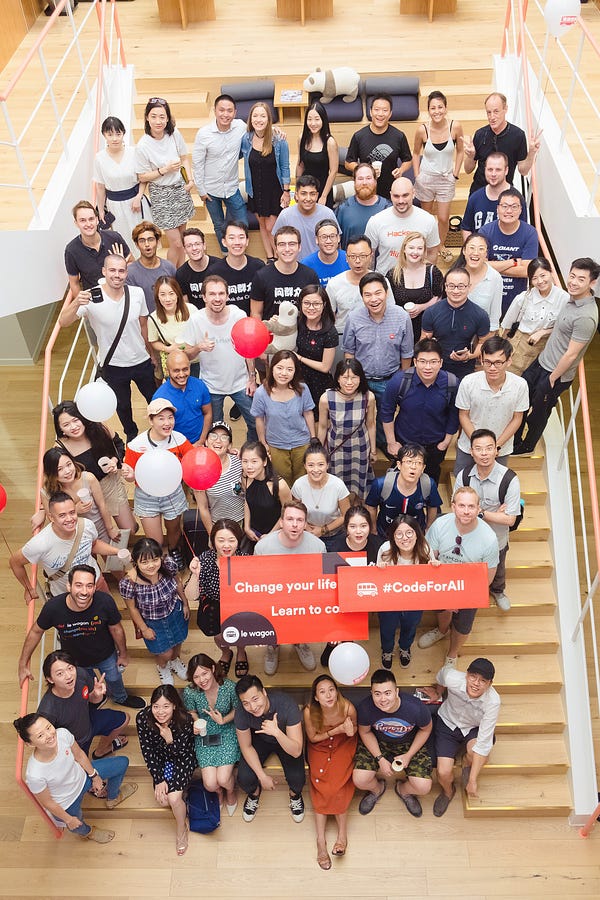
Look at all those friendly faces welcoming you to the tech world!
Step 1: Get in the right mindset
Some people are intimidated by tech, especially if they lack a technical background.
However, the tech community is actually a very welcoming place, and you belong here.
Moreover, you don’t need a computer science or IT degree to break into the industry. There are dozens of different roles, and most of them don’t require a CS degree.
You do, however, need to be realistic with your goals. Transitioning careers is never quick, and don’t expect to land a top job at a sexy tech company overnight. Eventually, you can make it there, but you need to be realistic.
Step 2: Know yourself
It may sound a bit silly that “know yourself” is a step in your transition, but I believe it’s the most important one. If you don’t know why you want to make this transition you’re going to get lost when things get hard along the way. And trust me, transitioning careers and learning new skills is a huge challenge.
Before you can land your perfect role take some time to reflect on your prior experiences and ask:

- What kind of work energizes you?
- Are you more analytical or more interpersonal?
- What past work experience has brought you the most satisfaction?
- What do you hope to achieve in the next 2–3 years of your career?
If you need some help cultivating self-awareness, then I recommend taking this Meyers-Briggs personality test. This will help you understand whether you’re more introverted or extraverted, more logical or emotional, more of a planner or an improviser.
You’ll want to place yourself along a general spectrum of “more analytical” to “more interpersonal,” and in the next section, I’ll show you some roles in tech along this spectrum.
Step 3: Understand the roles in tech — Hackers, Hipsters, Hustlers
As you transition to tech, it may be easy to think of the cool companies you want to work for instead of the roles you may be a fit for.
However, in order to land a job, you’ll need to focus on the role! HR and hiring managers are evaluating you as a fit for the job before they even consider whether you’d be a fit for the company.
If you’re completely new to tech it might be hard to understand the various roles, so to simplify things, let’s use the “Hacker, Hipster, Hustler” framework. You can categorize most roles into these three areas.

In the “hacker” department there are roles like software engineers, data scientists, network engineers, and DevOps engineers.
In the “hipster” department lives the UX researchers, UI designers, product managers and front-end developers.
And in the “hustler” category you’ll find business roles such as sales, digital marketing, growth, and business operations.
In general, it may be easier to transition to a new role if it exists along the same ‘analytical to interpersonal’ spectrum as your prior roles or studies. This is because a lot of the modes of thinking and working will be similar.
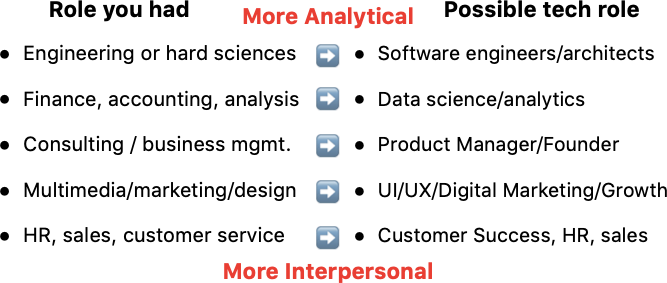
In my experience, I’ve seen clear trends of people moving laterally along this spectrum. You’re more likely to meet a data scientist who used to be a financial analyst than one who was a salesperson.
Now it’s your job to start researching a few roles in your area of interest and find out what they entail. Join meetups and talk to people working in tech, or take affordable online courses to learn more about various roles.
No matter what, it’s imperative that you find out the nitty-gritty about the job that interests you because in the next step you’re going to figure out what skills you need to qualify for that job.
Step 4: Find your perfect fit and skills gaps
Now that you know yourself and know the job you want, it’s time to figure out what transferable skills you (already!) have, and what skills you need to pick up.
You’ll need to pull out your resume and compare it to that dream job description and identify any skills gaps. A service like Jobscan can help you quickly compare your current resume to the job you want and help you see the holes.
Here are a few real-world examples of lateral career changers, along with how their prior work experience stacked up, and what skills they needed to learn.
Financial Analyst to Junior Data Scientist
This career transition from a traditional Excel-based quant to a data scientist is a very common one. Seasoned analysts actually have a lot of the hard and soft skills needed to succeed in a junior data scientist role. However, there are several crucial skills you need to pick up in order to be competitive, most notably Python, R, some visualization tools and knowledge of how to work with APIs. This can be achieved in just a few months through a data science bootcamp.
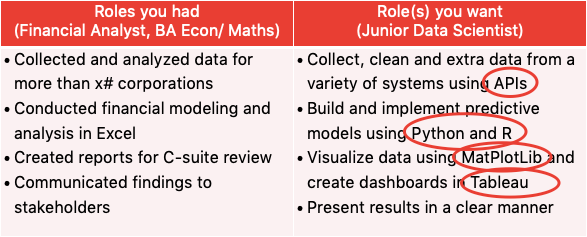
Side by side comparison of Financial Analyst resume with Jr. Data Scientist job description — the financial analyst already has most of the soft skills!
Consultant to Product Manager
Similarly, if you’re a consultant who’d like to get into product management, you’ve already got a lot of transferable skills, notably around business analysis, bringing something to market, and communicating with a variety of stakeholders. To be competitive, however, you’re going to have to learn how software gets built as well as how to collaborate with technical stakeholders such as developers and designers. You can pick up these required skills through a full-time or part-time product-focused bootcamp.
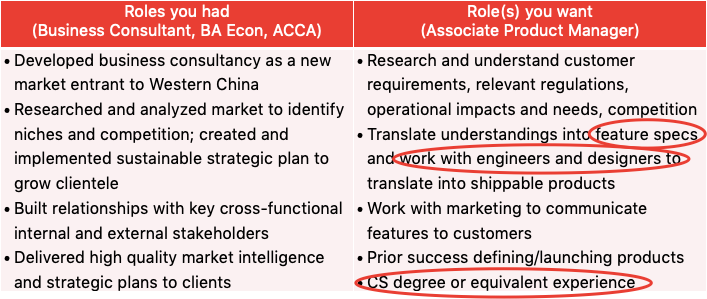
As you learn about more roles in tech, you may be pleasantly surprised to find that you already bring a lot of experience to the table, even if you come from a non-tech background. This is precisely why nobody should rule out a future in tech.
Step 5: Fill the gaps
Now that you’ve got an understanding of your skills gaps, there is one thing left to do before you start applying for jobs: fill any skills gaps!
Four-year or two-year degrees are hardly required for transitioning into tech (though I’ve counselled dozens of people down that route and wrote a guidebook on that topic), and I’ve personally seen dozens of bootcamp graduates transition from non-technical to tech roles in exciting companies.

Thankfully we live in a time with more education and training options at our fingertips than ever before. From free online courses to intensive bootcamps, it has never been cheaper or easier to up-skill in just a few weeks.
So whether you want to become a data scientist, product manager or something in between, there are a variety of training options to choose from.
So, what are you waiting for?!
Are you looking to change careers? Are you or your teams partially unemployed?
What if now was the right time to build your skills with Le Wagon and start the digital transformation of your business? 💪
Le Wagon is launching 3-day training courses 100% funded for employees on partial layoff 💰
🎨 UX / UI Design
Accelerate your projects through prototyping and establish your graphic charter
💻 Web Development
Understand what is behind a website and publish your company website
📊 Data Analysis
How to collect, clean, analyze and visualize your business data
For more information, get in touch with shannon@lewagon.org
Allen Sanchez is a Driver and Product Coach at Le Wagon China, former International Admissions Counselor for the University of California — Berkeley’s Master of Information of Data Science, and a champion for tech education.


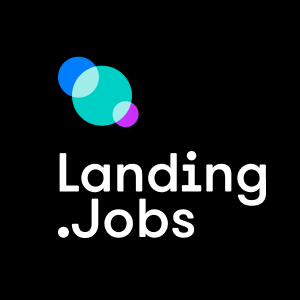



0 Comments